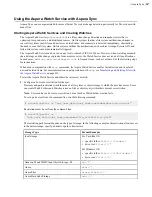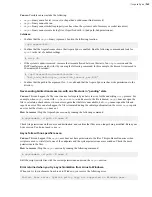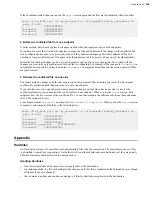
| Aspera Sync |
263
General
asyncadmin
usage:
# asyncadmin -d
path
[-N
name
][options]
The
-N
name
option is required if multiple Aspera Sync sessions are running; you must specify the name of the
session to which the
asyncadmin
command should apply.
Note:
When records are deleted using the
-M
or
-E
options, Aspera Sync recalculates file counters for the entire
database. This can take a while, depending on the size of the database.
Session Options
-A
Display the
asyncadmin
version.
-b
path
, --local-db-dir=
path
Specify the local database directory. The default location is the local Aspera Sync directory.
-C, --clean
Delete problem records (records with statuses of
CONF
,
PCONF
, and
ERR
).
-d
path
, --local-dir=
path
Specify the local Aspera Sync directory.
-E
number
, --erase=
number
Delete the specified file record by number.
-F, --force
Allow changes while database is in use.
-f, --file-info
Report the status of all files.
CAUTION:
The use of this option is not recommended on Windows, as it can cause
the database to lock and
async
to fail. An alternative is to use the
-t
option.
-h, --help
Display the
asyncadmin
command-line option help.
-j, --journal
List the changes that might be incomplete remotely.
-l, --list
List the snapshot databases found in the database directory.
-M
pattern
, --match=
pattern
Delete file records that have paths that match the specified pattern (path globbing).
-m, --meta
Report metadata.
-N
name
, --name=
name
Select a source-destination pair from the snapshot database by name.
-O, --compact
Compact the database file.
-p, --pause
Pause when displaying a large amount of file data (for example,
-f
).
-q, --quiet
















































